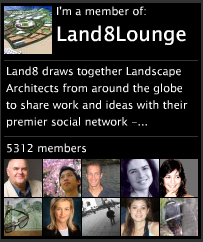One of the fairly unique features of this site is the granite outcropping that runs along its eastern edge. Giving a feature like this both realism and readability is something that requires multiple layers of textures, with manual manipulation required to give it an organic, natural feel.
I am again using a photo I took as the base for my granite material. This is made more challenging due to the fact that the photo I am using only has a small area of solid granite, in the form of Belgian block edging. I selected a few blocks that have similar tones, outlined in red, and used those as the base for my texture.
I used a mix of both healing brushes to fill in a large area using the existing blocks as a sample area. First I filled in the gaps with the healing brush, then I used the spot healing brush to smooth the transitions between the original and the pasted-in areas.
I then repeat this process to slowly spread the area out further until I have a large area filled with granite texture.
This area I then use to create my base granite material by simply cropping out the non-granite area of the photo. I also recommend looking for any obvious inconsistencies in the texture now, as you can use the healing brushes to eliminate them now.
You then simply use the same technique of pasting, fading, and cropping that has been used in the previous tutorials.
This texture is smooth enough that I am able to paste it into my image without needing a second layer of texture to mix it with, so for now simply add the texture into the drawing you have after creating a pattern.
While this granite outcropping now looks flat, although that will be helped with shading later in this series. However, this is the more unique portion of this tutorial: to give this cliff some real depth and realism, it is time to add some north-facing moss. First, Select a good moss pattern and fill a new layer with that pattern. I selected one of the turf patterns as the moss layer, as it has about the right color, and has some good texture depth to it.
I then place this layer above my granite layer, and assign a new, empty layer as a mask. I then re-select just the area filled with the granite.
You then want to select a brush with… for lack of a better description coming to mind, a spread, clumping form. I used a dual brush with medium scatter and a low count, as this gives you a good random spread, while keeping the brush in proximity to the cursor. (The dual brush essentially assigns a masking brush to another brush, so you can have one brush with a monster spread that would go to every corner of your canvas, but then you mask it with a 100 pixel wide round brush, so the only area the first brush will affect is the area also covered by the non-spreading brush.)
Then paint what would be the north facing areas of the slope on the masking layer, with the most paint going on the most north-facing areas.
This will start to give a nice additional level of depth to the image, especially once the shading is added later on.
Next time We will tackle the longer grasses that surround the house.












 Design + Tech RSS Feed
Design + Tech RSS Feed